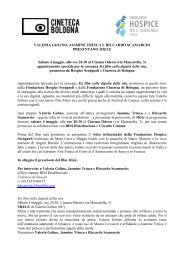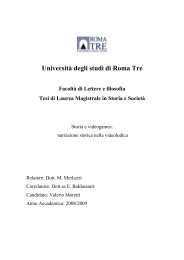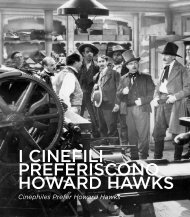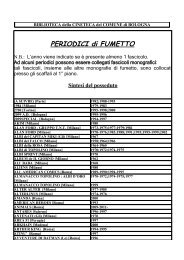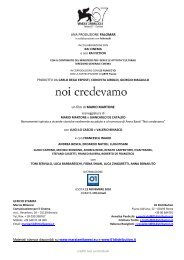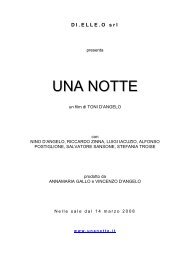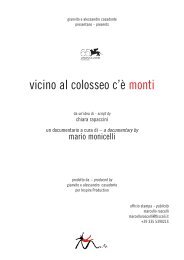Catalogo 1999 - Cineteca di Bologna
Catalogo 1999 - Cineteca di Bologna
Catalogo 1999 - Cineteca di Bologna
Create successful ePaper yourself
Turn your PDF publications into a flip-book with our unique Google optimized e-Paper software.
Unknown film, not included in Bernar<strong>di</strong>ni-Martinelli’s filmography, it tells the story of a treasure hunt<br />
across a beautiful portrait of Rome in the first part of the century. Places that will be visited by 100<br />
years of cinema (from Fellini to De Sica) are shown here for the first time. Naturally, we pass through<br />
Cines’ stu<strong>di</strong>os where the stars of the Company await the treasure hunters.<br />
Al termine del film, presso la segreteria del Festival in Piazza Maggiore, il Consolato d’Austria,<br />
l’Austria filmarchiv e l’Associazione per le ricerche <strong>di</strong> Storia del cinema offrono un aperitivo per la<br />
presentazione del volume Wiener Schatten de<strong>di</strong>cato al cinema muto austriaco.<br />
After the film the Austrian Consulate, Filmarchiv Austria and the Association for film history research are offering aperitifst the<br />
Festival Interpoint in Piazza Maggione for the presentation of the volume de<strong>di</strong>cated to Austrian Silent film, Wiener Schatten.<br />
ore 14.45<br />
Divine apparizioni / Divine apparitions - Vera Karalli<br />
DIE RACHE EINER FRAU (La vendetta <strong>di</strong> una donna / Germania, 1921). R.: Robert Wiene. In.:<br />
Vera Karalli, Franz Egenieff, Olga Engl, Boris Michailow.<br />
35mm. L.: 1719m. D.: 94’ a 16 f/s. Didascalie tedesche e russe / German and Russian intertitles.<br />
Da: Gosfilmofond of Russia<br />
Copia positiva stabilita nel 1988 a partire da un positivo nitrato, le <strong>di</strong>dascalie sono tradotte o fatte in<br />
Russia / Preserved in 1988 from an original nitrate positive, intertitles are translated or produced in<br />
Russia.<br />
Accompagnamento musicale <strong>di</strong> / Musical accompaniment by Donald Sosin<br />
Robert Wiene organizza l’unità del suo film intorno alla soggettività <strong>di</strong> Sanzia-Florinda. Egli consegue<br />
questo risultato creando una cornice all’azione che ha permesso <strong>di</strong> raccontare gran parte della storia in<br />
flashback, dal punto <strong>di</strong> vista della donna. Inoltre i primissimi piani, sia per numero sia per modalità,<br />
sono de<strong>di</strong>cati al mondo interiore <strong>di</strong> Sanzia-Florinda. Henri de Tessignies, che esplicitamente si situa al<br />
<strong>di</strong> fuori della storia, svolge una funzione narrativa come me<strong>di</strong>atore tra l’eroina tragica e il pubblico. È<br />
presente, ma come pretesto perché la storia sia raccontata. Egli, infatti, non influenza l’azione. La<br />
soggettività della storia <strong>di</strong> Sanzia-Florinda non viene minimamente scalfita da Henri. (Uli Jung, Walter<br />
Schatzberg, Robert Wiene, der Caligari-Regisseur, 1995)<br />
Robert Wiene centred his film around the subjectivity of Sanzia-Florinda. He achieved this by<br />
introducing a framework plot which enabled the greater part of the story to be told as a flashback, i.e.,<br />
from her point of view. What is more, the kind and the number of close-ups point constantly to Sanzia-<br />
Florinda’s inner world. Henri de Tessignies, who is deliberately not part of the story, assumes a<br />
narrative function, as me<strong>di</strong>ator between the tragic heroine and the au<strong>di</strong>ence. He is present everywhere,<br />
but only as an occasion for the story to be told. He himself does not influence the plot. The subjectivity<br />
of Sanzia-Florinda’s story is not affected by Henri. (Uli Jung, Walter Schatzberg, Robert Wiene, der<br />
Caligari-Regisseur, 1995)<br />
Vera Karalli (Wera Aleksejewna Karally, 1888-1972). Più nota come danzatrice - fu allieva <strong>di</strong> Gorskjl<br />
alla Scuola Imperiale <strong>di</strong> ballo moscovita e poi, dal 1906, scritturata al Bolshoi - Vera Karalli, che<br />
vantava origini greche, ha avuto una carriera densa <strong>di</strong> successi non limitati alla sola Russia; infatti<br />
Diaghilew se la portò a Parigi, facendole interpretare da protagonista Le Pavillon d’Armide <strong>di</strong> Fokin,<br />
spettacolo <strong>di</strong> punta dei Ballets Russes.



